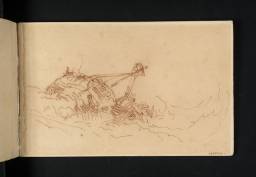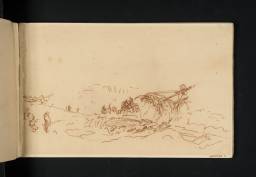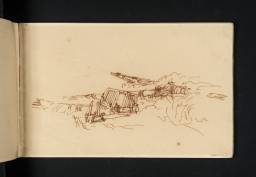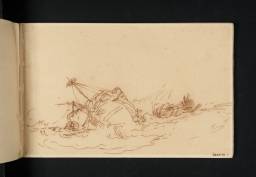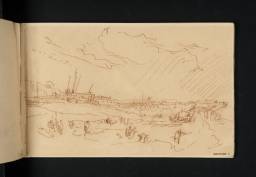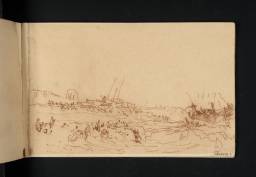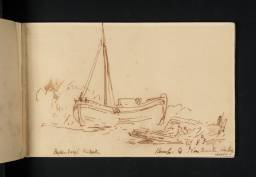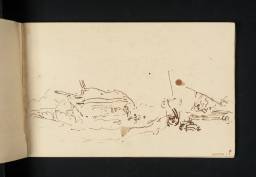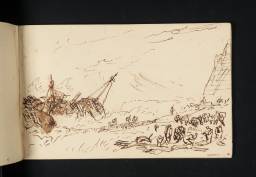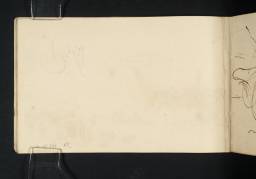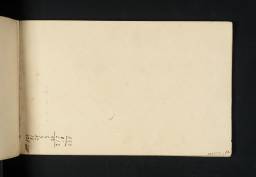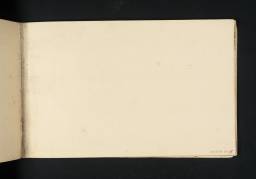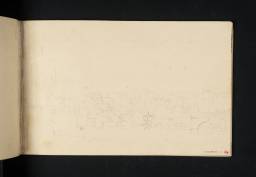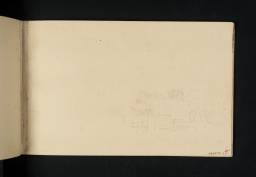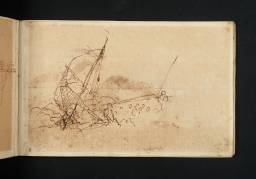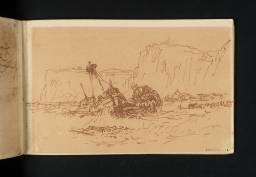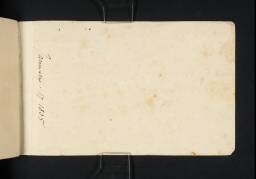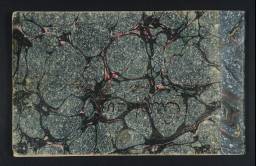Turner Bequest LXXXVIII
Pocket book, in blue and pink marbled paper covers
18 leaves of cream laid paper made on a single-faced mould
Approximate page size 119 x 189 mm
Made by John Larking at East Malling Mill, Kent, and watermarked with an ornamental fleur-de-lys incorporating the letter L and ‘1801’ or countermarked ‘J LARKING’. Probably bound by William Dickie at 120 The Strand, London
An additional ten blank leaves made by Van Gelder Zonen, watermarked ‘VGZ’ and with a dancing man on a globe, were added circa 1934
Inscribed, possibly by Turner, in ink ‘Catalogue of Mr Cooke’s Drawings’ on back cover and ‘January 17 1805’ inside back cover
Endorsed by the Executors of the Turner Bequest, Henry Scott Trimmer and Charles Turner, and inscribed in ink ‘No 190. This book contains 13 leaves, some Pencil and some pen and Ink | H.S. Trimmer | C. Turner’, and by John Prescott Knight ‘JPK’ and Charles Lock Eastlake ‘CLE’
on a label on the front cover. Also inscribed by Arthur Mayger Hind in pencil inside front cover ‘Restitched & blanks added | to complete 28 leaves’
18 leaves of cream laid paper made on a single-faced mould
Approximate page size 119 x 189 mm
Made by John Larking at East Malling Mill, Kent, and watermarked with an ornamental fleur-de-lys incorporating the letter L and ‘1801’ or countermarked ‘J LARKING’. Probably bound by William Dickie at 120 The Strand, London
An additional ten blank leaves made by Van Gelder Zonen, watermarked ‘VGZ’ and with a dancing man on a globe, were added circa 1934
Inscribed, possibly by Turner, in ink ‘Catalogue of Mr Cooke’s Drawings’ on back cover and ‘January 17 1805’ inside back cover
Endorsed by the Executors of the Turner Bequest, Henry Scott Trimmer and Charles Turner, and inscribed in ink ‘No 190. This book contains 13 leaves, some Pencil and some pen and Ink | H.S. Trimmer | C. Turner’, and by John Prescott Knight ‘JPK’ and Charles Lock Eastlake ‘CLE’
on a label on the front cover. Also inscribed by Arthur Mayger Hind in pencil inside front cover ‘Restitched & blanks added | to complete 28 leaves’
Accepted by the nation as part of the Turner Bequest, 1856
Exhibition history
References
This sketchbook contains various sketches of stranded or wrecked vessels aground or close to shore, sometimes with salvagers at work in the surf, and two Thames views similar to View of Richmond Hill and Bridge exhibited in Turner’s Gallery, 1808 but begun earlier.1 The book was probably mainly in use in 1805.
Ruskin selected eight leaves of ‘studies of a shipwreck and stranded boat’ for the early displays at the National Gallery, declaring ‘I believe even those who have not seen a shipwreck, must recognize, by the instinct of awe, the truth of these records of a vessel’s ruin’ and placing them as ‘examples of Turner’s period of development (1775–1800)’. This dating was incorrect and Finberg assigned the book to 1805. Although convincing, this redating has itself tended to rest on shaky ground – a direct link to the wreck subjects in Turner’s Shipwreck (1) sketchbook (Tate D05376–D05427; D40694–D40696; Turner Bequest LXXXVII), with which this book is uniform, and an assumption (made for example by Wilkinson) that both books were devoted to the same project, Turner’s picture The Shipwreck (Tate N00746), exhibited at Turner’s Gallery in 1805.2 This is misleading, for only folio 18 (D05444; Turner Bequest LXXXVIII 17) is closely related in theme and technique, and in fact it probably belonged to the other book and was associated with this one in error by Ruskin, or perhaps by Ralph Wornum when choosing works for national tour in the Third Loan Collection (see below).
Shipwreck (1) mostly shows large ships in open seas and imaginary scenes or reconstructions of events Turner had not witnessed. The sketches in the present book predominantly show coastal wrecks and look like studies from life, drawn in a sharper, more documentary manner in pen and ink, occasionally with a little wash. Most appear to show the progressive breaking up of the same vessels after they have run aground. Sometimes there are figures and one wonders whether they are always salvagers, or perhaps wreckers or smugglers. In the Inventory Finberg associated some of the sketches with Folkestone and in Sketches and Drawings, where he assigned them to Shipwreck (1), described them as ‘the succinct record of an actual shipwreck’ and ‘so many different views of a barque going to pieces on the shore’.3 He did not elaborate on his Folkestone suggestion, but it is perfectly possible that they were drawn on the south coast; coastline and cliffs are sometimes reminiscent of Hastings as well. Perhaps the date inside the back cover, 17 January 1805, is that of events depicted and follows on from his trip to Sheerness and Chatham around Christmas 1805 to see the Victory return from the Battle of Trafalgar; see Introduction and notes to the Nelson sketchbook (Tate D05446–D05490; D40701–D40705; D41427; Turner Bequest LXXXIX). Turner certainly had both the Shipwreck (1) and Nelson books with him then, as their contents overlap, and as this one was identical he probably took it along as well. The only information given by Turner on the subjects in the book is his note that the barge-like boat on folio 8 (D05435) is a ‘Pappenburgh vessel’, indicating that she comes from Papenburg, the trading and ship-building port on the estuary of the River Ems.
The citation on the back cover of a catalogue of ‘Mr Cooke’s Drawings’ must be later, referring to some aspect of Turner’s dealings with the engraver and publisher William Bernard Cooke (1778–1855) and his brother George (1781–1834), also an engraver. Both were engravers of Turner and from 1822 to 1824 the elder held annual loan exhibitions of drawings and watercolours, mainly Turner’s and including both specially-commissioned works and others used for his own publications. Among them were watercolours intended for an unpublished series of engraved ‘Marine Views’ and others of the east coast of England.
If this indicates later use of the book, the view of the Thames at Richmond spread over folios 14 and 15 (D05441–D05442) is likely to date from 1805, when, during the summer, Turner made many studies of the river west of London. Drawn in pencil, it is more probably a study from nature than directly connected with the 1808 picture.
Technical notes
How to cite
David Blayney Brown, ‘Shipwreck (2) sketchbook c.1805’, sketchbook, February 2006, in David Blayney Brown (ed.), J.M.W. Turner: Sketchbooks, Drawings and Watercolours, Tate Research Publication, December 2012, https://www

